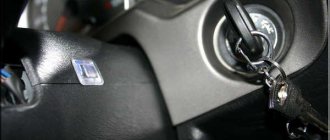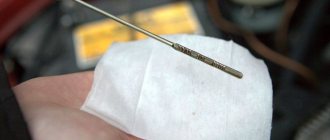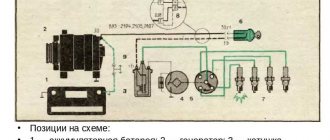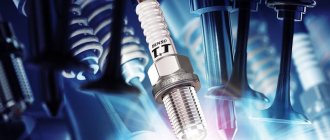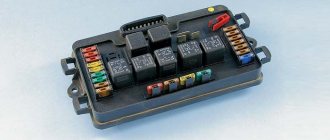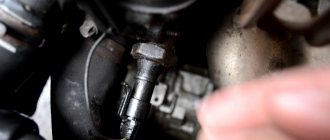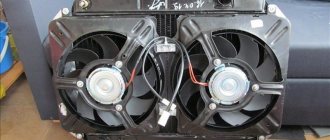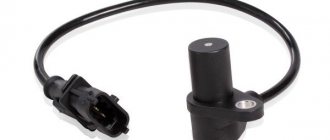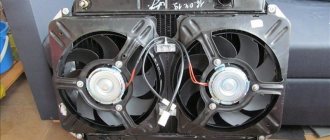ABS or Anti-lock braking system. This is a complex system that prevents four wheels from simultaneously locking during braking, ensuring maximum vehicle stability. It includes systems: traction control, emergency braking and electronic handling control.
The essence of its operation is to reduce the pressure in the brakes in order to allow the wheel to turn rather than stop instantly, increasing the braking distance of the car. Experienced drivers do this on slippery, wet and gravel roads, which helps keep the car from skidding. And now automation, more precisely ABS, does this.
ABS components
The system components are:
- A speed sensor installed on the wheels, or more precisely on the hubs.
- Hydraulic drive
- Brake line pressure control valves
- ECU - control unit
The main purpose of this complex is to maintain the driver’s ability to maneuver during braking, while maintaining full control over the vehicle. The advent of an anti-lock mechanism made it possible to introduce an emergency braking assistance system (EBAS). It increases braking force on slippery sections of the road, which could cause the car to slide due to complete blocking of the wheels. However, ABS partially unblocks them, preventing this. SPED has the ability to fully function.
Criterias of choice
In order to avoid making mistakes when choosing, it is recommended:
- search for the necessary spare parts by VIN code;
- determine compatibility using electronic catalogs indicating the car make, body, year of manufacture and engine type;
- read the code on the body of the old sensor to select a similar or closest analogue in terms of characteristics;
- pay attention to the shape of the part, which can only fit a specific wheel for the left or right side of the installation or be universal;
- look for the desired device among the products of proven reliable manufacturers.
ABS sensors
Some speed sensors operate on a principle based on the magnetoresistive effect. Others use the Hall effect. There are passive and active varieties.
Passive sensors are large in size and begin to record readings only when they reach 5–7 km/h. They are less susceptible to wear, and contamination does not interfere (due to the design).
Active analogs appeared at the end of the last century, in the 90s. The work is based on the properties of semiconductor diodes, which change the direction of current under the influence of a magnetic field. These are magnetoresistive sensors. There are Hall sensors based on the phenomenon of current generation in resistance placed in a magnetic field.
In both cases, the source of the magnetic field (ring) is fixed to the hub and moves with it. In the first case, changes in the field cause the electrons to change direction, changing the corresponding resistance value. This is transmitted to the ECU.
In the second option, a changing magnetic field moves electrons to one end of the conductor, creating a constant voltage that is transmitted to the ECU. A significant disadvantage is the susceptibility to interference.
Factors that provoke various problems in sensors:
— weak resistance of the magnetic field to various interferences
— the installation location contributes to severe contamination
- mechanical influence of wheel movement - vibrations, vibrations, shocks, etc.
What is the danger of such a situation?
The safety of moving a car lies in complete control over it, under any conditions. While the wheels rotate along the braking distance, the driver directs the car in the desired direction with his own hands. If the car does not have time to stop before the obstacle, you can go around it. But modern brakes are so powerful that the wheels lock on even the slightest slippery surface, and sometimes even on dry asphalt. In Moscow, the speed limit on the Moscow Ring Road is up to 110 km/h. Under such conditions, even the most advanced tire will slip when braking.
What should automakers do? Reduce braking force? It is unacceptable.
In the 70s of the last century, a solution was found: the anti-lock braking system (ABS).
The technology allows you to maintain vehicle controllability during braking. The wheels are not blocked, therefore, the car obediently follows the steering.
Common problems with ABS
Even complete failure of ABS does not cause the engine to stop. The car simply switches to normal braking mode. However, before this, the system will give some signals of its “disease”.
The indicator on the instrument panel lights up. It should go out a few seconds after the start. If this does not happen, then there is a problem with the sensor. In other situations, the indicator lights up only while driving, and at low speeds - 20 - 25 km/h. It doesn’t hurt to first check the wheels for the same tire pressure, synchronous tread wear, and the same size of all four tires.
Of the many reasons for problems with the system, we can highlight the most common ones, which any car enthusiast can handle on their own (if their hands grow from where they should):
- Self-diagnosis displays an error, changes in angular rates are not displayed, and the ABS function is disabled. The reason for this is a malfunction in the unit and an open circuit of the sensor (break, contact failure, short circuit)
- After finding the error, a breakdown of the wheel sensor is detected. However, the system continues to work. Problems with the wiring of these sensors usually result in oxidation of wires and contacts, intermittent power supply and short circuit to ground.
- Spontaneous short-term braking, no information about angular acceleration is received. This happens when tires with different degrees of wear are installed, the pressure in them is different, and the tread wear is not the same.
- ABS does not turn on at all. There are several reasons: damage to the pump, wear of the wheel bearings, damage to the sensor (its rotor), breakage of its wire or the formation of play, breakdown of grids and bearing separators.
Symptoms of a device malfunction
The fact that the ABS sensor is faulty will be indicated by an indicator on the instrument panel - it lights up when the system is deactivated, which turns off even if there is the slightest problem.
Evidence that ABS has ceased to “interfere” with the operation of the brakes:
- Wheels constantly lock during heavy braking.
- There is no characteristic knocking noise with simultaneous vibration when pressing the brake pedal.
- The speedometer needle is delayed relative to acceleration or does not move from its original position at all.
- If two (or more) sensors on the dashboard are faulty, the parking brake indicator also lights up and does not go out.
The ABS indicator on the dashboard indicates a system malfunction
What to do if the ABS warning lamp on the car’s dashboard does not behave quite correctly? You should not immediately change the sensor; first, the devices should be checked - this procedure can be performed independently, without resorting to the services of highly paid craftsmen.
DIY ABS sensor diagnostics
The most difficult and expensive part of ABS to check is the control unit. However, problems with it arise less often. The safety relay protects it from surges, significant dips and drops in voltage from the battery.
But wheel sensors are the most vulnerable part of ABS. This has to do with their location. They are installed near moving elements (axle shafts and hubs) and are exposed to influence from them. Provocateurs for the occurrence of malfunctions in them, up to complete failure, are easily penetrating dirt and expanding play in the bearings.
You need to stock up on a multimeter, a tester, and soldering.
The inspection is carried out in stages, moving from simple to more complex.
- Removing the sensor
- Cleaning from dirt. Use kerosene or “white” alcohol. Particular attention should be paid to the teeth of the wheel hub, from which the device reads revolutions. They quickly become clogged with dirt, which distorts the sensor data and, as a consequence, the ABS freezes. Clean the sensor itself.
- Measure the resistance of the part and compare it with the standard set by the manufacturer. Find it in the directory or ask the seller.
- You need to measure the voltage while the wheel is rotating. Raise the car on a jack, release the wheel for free spin. Connect the multimeter, rotate the wheel, and take readings of the voltage change. Compare with reference data.
- Move on to bearings . Scroll it several times. Check the ease of sliding, determine the serviceability of the sensor with a multimeter. Clean everything thoroughly.
- Now you need to look at the relay , if no breakdowns have been identified before this stage. There is a plastic cover on it, and a fuse is installed under it. First of all, it needs to be checked and replaced.
To check the relay you need:
- Disconnect it from the block connector;
- Use a multimeter to connect to the first and second contacts of the connector (there are a total of 25 numbered contacts in the connector);
- Turn on the ignition. The meter should provide 20V electrical current to the on-board network;
- If there is no voltage, check the integrity of the connection between contact No. 2 and the body ground using the negative probe. Provided that the fuse is intact;
- Disconnect the relay itself and connect its pins No. 5 and No. 6 directly to the battery. A working part will start to click.
- Scanner testing. The ABS wheel sensor is of the induction type - equipped with a magnetized core in the winding. The magnetic field that appears on the core when current passes through the coil forms a flux. It is interrupted by the teeth of the rotating rotor, creating electromagnetic pulses. The amplitude of the pulse voltage fluctuation is the level of the sensor signal to the block. The measurement is made by a scanner. The resistance in a working part is 750 - 1200 Ohm. Resistance tending to infinity indicates a break. Its zero reading is a short circuit. In this way, “ring” all the sensor wires.
By the way, set the tester to the “diode” state, since protective diodes are included in the sensor circuit. A simple measurement may not reveal distortion.
- on insulation - more than 20 Ohm
— front leg – 7 – 25 Ohm
— rear leg – 6 – 24 Ohm
A detected sensor failure means only one thing - it needs to be replaced. It cannot be repaired.
Checking the ABS system
If the touch sensor malfunctions, it stops sending commands to the system, and the ABS does not fulfill its task, that is, the wheels are blocked when braking. If you have such a problem, you should immediately contact a car service center.
The sensors of the simplest equipment are an ordinary induction coil interacting with a toothed metal disk. The most common cause of ABS failure is a broken cable. This type of fault is diagnosed using a tester, repair pins and a soldering iron. The pins are connected to the connectors, and the resistance of the ABC sensor is measured using the tester.
This indicator should not exceed the values specified in the operating instructions. If the resistance approaches infinity, this means that a break has occurred in the electrical circuit. If it tends to zero, then we are talking about a short circuit.
If breaks are identified during a visual examination, they need to be repaired urgently. To connect them, you need to use soldering, since ordinary twisting can lead to worsening damage.
Many modern cars have a special automatic diagnostic system installed. If there is any problem, the electronics issues one or another repair code, which is deciphered using the vehicle manual.
Generations and species
The modern system installed on a car is four-channel. It includes two valves for each wheel, as well as one pressure accumulator and shock-absorbing chamber per circuit (of which there are two).
In general, this system already has 5 generations. The first of them appeared in 1978, the second replaced it in 1980 and was installed until 1995, after which the 2nd generation replaced the 3rd. The modern 4th generation of the system appeared in 2003, and now the 5th generation is in use, which continues to be used to this day.
In terms of design features, the four-channel system is the latest and most technologically advanced. But it was preceded by:
- single-channel system (it used only two valves, which regulated the pressure in all lines simultaneously. It is noteworthy that in the single-channel type the system usually made adjustments only in the drive axle mechanisms, that is, the ABS worked only with two wheels);
- two-channel (in this type of ABS, the brake mechanisms are divided along the sides, each of which has its own set of valves. That is, one channel combines the mechanisms of the front and rear wheels of one side);
- Three-channel (it provided one set of valves for the wheels of the rear axle, and the front ones were each equipped with its own channel).
Nowadays, these three types of ABS systems are found only on older cars.
Brand tour
The highest quality sensors are OEM ones. They are tested at the manufacturer's plant, and then at the automaker's factories. As a result, the driver receives a durable part that will fit his car. The price of such an original is higher than the price of analogues.
The clear leaders in the production of analog ABS sensors are Bosch, Textar (Germany), Delphi (USA). There is not much difference between their products and OEM parts.
Mid-price products are represented by ABS (Netherlands), JP Group (Denmark) and Optimal (Germany). Besides Bosch, their sensors are inferior, but in the long run they only fail more often.
The most inexpensive, but still high-quality sensors are represented by three German manufacturers: Dello, AutoMega, Torpan. If you want to save money, buy products from one of these companies, and not some “noname”.
Improvements and improvements
Engineers have brought the ABS design to a high level and there is practically nothing to improve. Only some components are subject to modifications. Thus, wheel sensors now not only measure rotation speed, they additionally integrate G-sensors and accelerometers.
Improvements also include increasing the functionality of the electronic unit (that is, the use of ABS as a basis for other systems). For example, the ABS control unit is used in the traction control system and brake force distribution.
The best manufacturers
If you don’t know which company’s DSA is best to install on your car, then use the recommendations of specialists. Most often, they persuade drivers to use models from well-known brands. The latter value their reputation, so they supply only proven, high-quality devices to the domestic market.
Best manufacturers:
- StartVOLT (Russia);
- SAILING (China);
- BOSCH (Germany);
- ASAM (Romania);
- DELPHI (UK);
- Te Parts (Latvia);
- Nissan (Japan);
- Hyundai (South Korea);
- Febi (Germany).
Inductive type element design
Since inductive sensors are the most common, their design will be considered in the future.
Such a sensor consists of an inductive coil, inside of which a magnetic core is placed. It is installed next to the toothed impulse ring, but so that there is a certain gap between them.
When the wheel rotates, the ring teeth pass through the magnetic field created by the core, which affects the magnetic flux, causing the alternating voltage value in the coil winding to change.
As a result, the speed of rotation of the wheel, and with it the pulse ring, affects the frequency and amplitude of oscillations of the output voltage on the coil. These parameters are fed to the “brains”, as a result of which they estimate the speed of deceleration of the wheel.
Problems with at least one of the ABS sensors can lead to a complete shutdown of the system. And although the braking system on the car will work, you can forget about the braking efficiency and safety that ABS provided.
Where can I buy
Popular models and new items can be purchased in specialized stores and showrooms that sell spare parts and accessories for motor vehicles. Managers will explain in detail and also give useful tips and recommendations - what types of sensors there are, which company is better to buy, how to choose, how much it costs.
If there is no opportunity to buy the necessary spare part at your place of residence, the best inexpensive models are always available to order online in the online store. This can be done easily through the Yandex.Market aggregator or leading online trading platforms that offer to select the desired product based on various parameters - VIN code, car make or model, etc. At the same time, there is always the opportunity to look at the description, study the characteristics, reviews and photos, and also consider the possibility of selecting analogues of the original parts.
About braking efficiency
There is nothing wrong with ABS failure. The system only helps the driver to brake, and does not completely take over the work of the brakes. In the event of a malfunction, you should be prepared for possible difficulties in driving and the risk that the car will skid. The following has a serious impact on the course and braking distance:
- Tire condition;
- Condition of brake discs, pads and calipers;
- Condition of hydraulic brake drive elements;
- Car suspension condition.
Obviously, a vehicle with parts in perfect condition not only drives well, but also stops well. Brakes and pads need to be taken seriously. The ABS system works better with disc brakes.
